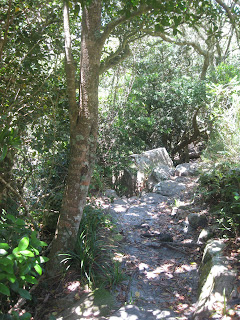I dodged ranger patrol duty because I was told the Sunday after Christmas the beaches were expected to be packed and that there would be a lot of law enforcement going on. Yuck! I opted to do some more hiking in the Silvermine area, alone, so that I could plod along at my leisure and take pictures and better study fynbos vegetation.
A ranger has fussed at me for only taking photos of blooming plants. What about rock formations? What about caves? What about ocean views? What about ANYTHING else? Well, buddy, I’m in the Cape Floral Kingdom for perhaps the only time of my life, this is the smallest yet most diverse plant kingdom on the planet, I’m only here a few weeks, and am only seeing a small portion of this diversity, and, well, hey, I’m interested in regional plants. I’m not interested in rock formations and I’m not interested in caves. Birds are elusive, (large) animals are rare, and hey, if you’ve seen one ocean view, really, haven’t you seen them all?
And then I thought about you guys; because after all, if you’ve seen one flower, you’ve seen them all, right? So I apologize for boring you with all of my exciting Cape Floral Kingdom. It could be worse: I could be interested in lichen!
So I loved my day after Christmas, hiking all alone in the mountain fynbos, hiking and taking my time. I found my way to the second of the two patches of indigenous forest in the Silvermine Valley region, along Echo Valley to the Kroon se Bos forest, otherwise known as Amazon Forest. (However, I don’t know why it is also known as the Amazon Forest).
I’m passing along some information about the forests from Mountains in the Sea: Table Mountain to Cape Point: An Interpretive Guide to the Table Mountain National Park, 2004:
Afromontane Forest, as its name implies, describes the forest associated with the mountains of Africa, and is found in patches throughout the continent. Generally, Afromontane forest is found below an altitude of 1,000 m and, in the south, it can grow close to sea level (as on the peninsula). Usually found in canyons or on the cool, south and south-east facing slopes, this forest requires at least 800 mm of rain annually, supplemented by mist. It is of medium to tall height (15m to 30m), evergreen, and grows on reasonably nutrient-rich soils that have good water retention. It is dominated by a relatively small number of trees like the Rooiels (Cunonia capensis), Assegaai Tree (Curtisia dentata), Bastard Saffronwood (Cassine piragua), Ironwood (Olea capensis), Hard Pear (Olinia ventosa), Cape Beech (Rapanea melanophloeos), Cape Holly (Ilex mitis), Sinkwood (Ocotea bullata) and the Real Yellowwood (Podocarpus latifolius). Some 10 to 20 species are common to all Afromontane forest which does not boast high species diversity. This forest does not support large numbers of vertebrate animals, and the fruits of its trees are dispersed mainly by birds. Because its foliage has a low flammability, most fires are only able to singe the forest margins, leaving the heart intact. This is why there is usually a relatively abrupt transition between the forest and adjoining fire-prone fynbos.
There is no record of the size of the indigenous forests on the Cape Peninsula before the arrival of the European colonists. Presumably they were more extensive—particularly in a place like Hout Bay, which was named for its trees—but the forest habitat would always have been restricted by the nature of the Peninsula’s geography, and the mountainside would not have been covered in a continuous forest belt, as is often presumed. The indigenous Khoekhoen and San probably had only a minimal impact on the forests, through their use of fire—affecting mainly the forest margins—and the harvesting of saplings for poles and assegaais (spears). But the arrival of the settlers changed all that. The new colonial society was totally wood-dependent; and it has been estimated that within just 50 to 70 years of the arrival of the first Europeans, local indigenous forest had been decimated. . . . In the Park, 33 species of forest tree have been recorded. Because of the dense shade under the forest canopy, only a few other plants are able to grow. The most common species are ferns. In this dark shade, rocks and boulders are soon covered with the lesser plants: mosses and liverworts. The cool, moist, nutrient-rich forest floor abounds with life, although not many of the large and spectacular variety. Mites, insect larvae, springtails, centipedes, millipedes, dung beetles, earthworms, mountain cockroaches, stick insects, woodlice, slugs, harvestmen, sowbugs and amphipods are among the invertebrates which occur here—many of them endemic—and which all play a very important role in forest ecology (58-59).
I was a happy girl sitting inside an old-growth forest that hasn’t been bothered by humans. Walking into the forests out of the bright mountain sun felt like entering a cool, moist cave: the air felt cold, the air smelled of earth, and the forest was quiet and still. The forest FELT old! It reminded me of our gorgeous forests back home—and made this girl happy!
I’m posting photos of the forest here on the blog, but if you’d like to see even more photos of the mountain fynbos, of the plants I passed while hiking to the Kroon se Bos forest, then see my public Facebook page. You need not be a member of Facebook to see these photos:
Soon,
Karen





dearest karen,
ReplyDeleteyou LOOK radiant with happiness! so glad for you! what a wonderful opportunity. i can't think of anyone who deserves it more. you were made to drink in such beauty...you're naturally absorptive and so sensitive.
i love you and miss you. happy christmas, and a blest new year in your new and sweetly yielding old continent.
kara
Thanks Kara... You're a DEAR!
ReplyDelete